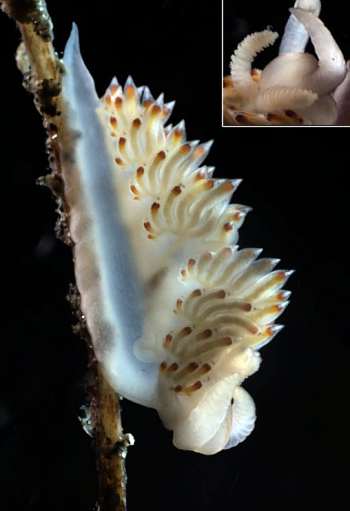
Flabellina pricei
(Macfarland, 1966)
Order: NUDIBRANCHIA
Suborder: AEOLIDINA
Family: Flabellinidae
DISTRIBUTION
Northeast Pacific from Ketchikan, Alaska to La Jolla, California.
PHOTO
La Jolla Shores, 16 m, California, USA, Eastern Pacific Oceean, 18 February 2006. Photographer: Mike Neubig.
Flabellina pricei is distinguished by its whitish body coloration. The slender cerata are arranged in distinctive rows; each ceras is yellow-creamish colored, with a white tip and a subapical brown band. The ceratal cores are green to brown, depending upon its recent prey. Specimens reach 25 mm in length.
This species feeds on the hydroids, Halecium and Corymorpha palma. It was named posthumously by Frank Mace MacFarland, to recognize Professor George Price, then the director of Hopkins Marine Station in Monterey, California
-
Behrens, D.W. & Hermosillo, A. 2005. Eastern Pacific Nudibranchs - A guide to the opisthobranchs from Alaska to Central America. Sea Challengers. 137 pp.
-
MacFarland, Frank Mace. 1966. Studies of opisthobranchiate mollusks of the Pacific coast of North America. Calif. Acad. Sci. Mem. 6: xvi + 546 pp.
Behrens, D.W, 2006 (March 2) Flabellina pricei (Macfarland, 1966). [In] Sea Slug Forum. Australian Museum, Sydney. Available from http://www.seaslugforum.net/find/flabpric
Related messages
Mating Flabellina pricei
January 8, 2007
From: Scott Gietler
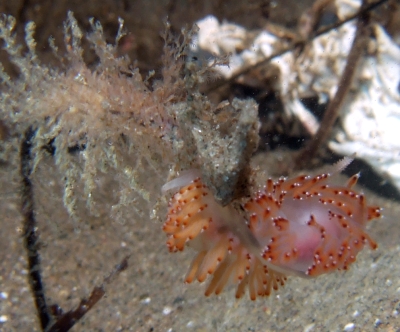
I thought I'd send in two photos of Flabellina pricei, since I've seen them on two dives recently, feeding on hydroids and mating near the Redondo submarine canyon. This nudibranch is not common in Los Angeles, but I've observed in on 3 dives in a row during the past week.
Locality: Redondo Beach, 37 feet, California, USA, Pacific Ocean, 23 December 2006, Sandy bottom. Length: 1 inch. Photographer: Scott Gietler.
Scott
sgietler@yahoo.com
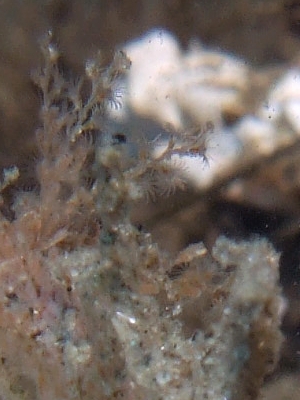
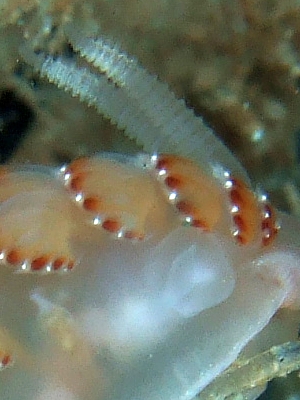
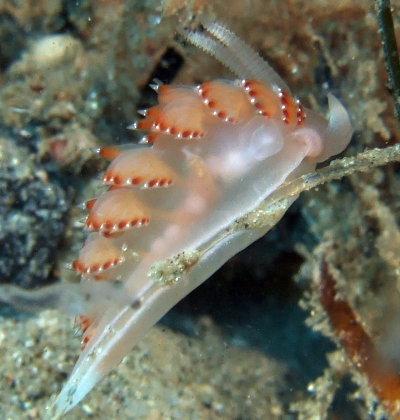
Hi Scott,
Great photos. We really appreciate you sharing these observations. I am not certain this pair is mating as the seem juxtiposed head to head. In any event, they are definitely feeding on this hydroid colony.Aeolids are one of the nudibranch groups that display widely varying population shifts. We believe these shifting numbers, follow the abundance of their food resources, which in your case are the hydroids (probably a species of Graveia ) shown in this closeup. When the food resouce dwindles, they lay eggs and disappear for awhile.
Bill has provided a close up here showing the detail of the annulate rhinophores of this species, and the arrangement of the cerata in ridges beginning adjacent to the rhinophores. You can also see the genital aperture in these photos.
Thanks for sharing this,
Dave Behrens
Flabellina pricei feeding
September 4, 2006
From: Kevin Lee
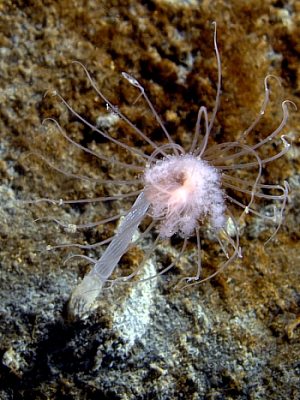
Hi Doc,
During my last dive, I saw a strange "stalked" organism, about 3.5 inches tall (foto A). It reminded me of a Windmill Worm, but, with the tentacle-like appendages, is perhaps a type of anenome? Anyway, nearby, I saw another one, only this time with some nudibranchs on it. Two of the branchs resemble each other (H. crassicornis?), but the larger one, with only cerata visible, seems to be a different species? Are you able to ID any of the creatures in the fotos?
Locality: La Jolla Shores Canyon, Main Wall, 60fsw, California, USA, Eastern Pacific, 27 August 2006, Sandy bottom. Length: approx 1.4 cm. Photographer: Kevin Lee.
PS: at the base of the stalked organism, is what appears to be an egg coil. Perhaps Jeff knows what species it belongs to. Strangely, the organism did not retract, despite all the nudibranch activity on it.
Thanks,
K:-)
diverkevin@gmail.com
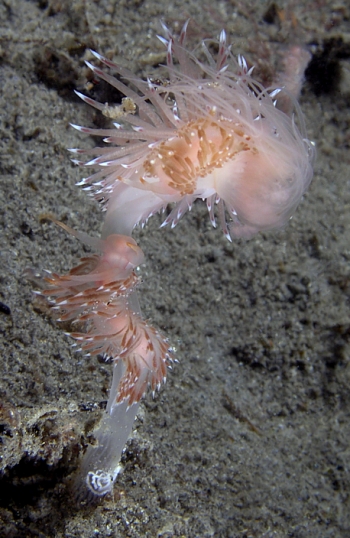
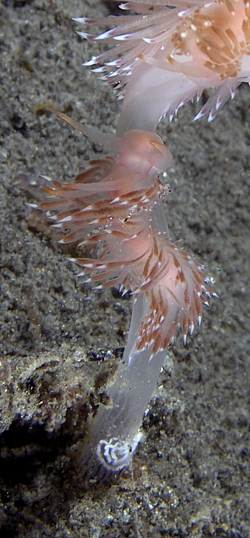
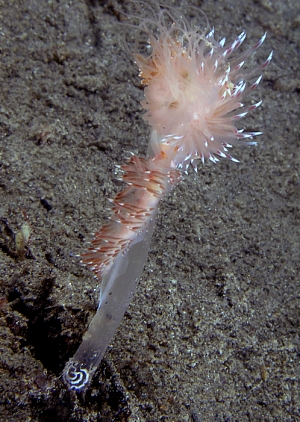
Hi Kevin,
Let's start with the stalked critter. This is the tubularid hydroid, Ectopleura marina.
As for the nudibranch, this is Flabellina pricei MacFarland, 1966). These two specimens mean to make a fast meal of this hydroid.
Not sure the egg mass belongs to them. It is quite small, compared to the slugs.
Best wishes,
Dave Behrens
Flabellina pricei from San Diego
February 22, 2006
From: Mike Neubig

Hi Bill,
In case these photos are indeed Flabellina pricei, I'm sending them for the collection. Except for possible reflection off the sand, the photos are 100% back-lit (2 HIDs). Even the blades of (dead) surf grass (Phyllospadix?) appear via transmitted light (encrusted portions are near-black).
Locality: La Jolla Shores, 16 m, California, USA, Eastern Pacific Oceean, 18 February 2006, sandy bottom. Length: 25 mm. Photographer: Mike Neubig.
Same site within 10 m: Polycera hedgpethi (message #15905 ), Dirona picta, Triopha maculata, and Dendronotus frondosus.
Cheers,
Mike
mike.neubig@gmail.com
Neubig, M., 2006 (Feb 22) Flabellina pricei from San Diego. [Message in] Sea Slug Forum. Australian Museum, Sydney. Available from http://www.seaslugforum.net/find/15906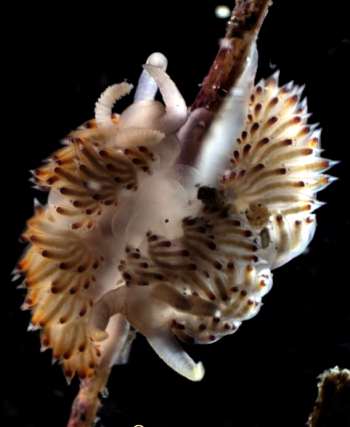
Dear Mike,
Well I guess I need to prepare a Fact Sheet for this species now that you have sent in these great photos. This is indeed Flabellina pricei (MacFarland, 1966). The white perfoliate rhinophores (shown in the insert)and the distinctive colored cerata are key characters.
This species was dedicated to Professor George Price then Director of the Hopkins Marine Station in Monterey, California.
Your specimens, shown here, were collected at the very southernmost end of this species documented range. To the north it has been reported to Alaska.
Best wishes,
Dave Behrens
